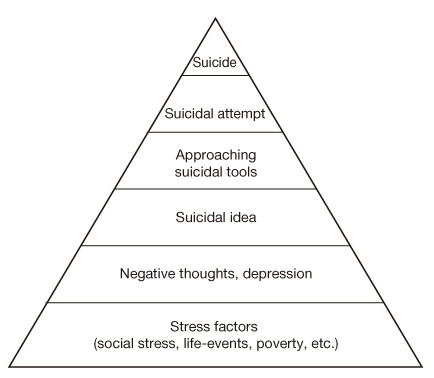 |
 |
- Search
| J Korean Med Assoc > Volume 54(4); 2011 > Article |
Abstract
Even though suicide ranks as the fourth cause of death and is causing a significant loss in Korea, it seems that the conventional notion regarding suicide as a feasible way of solving a troublesome life situation hinders early recognition and proper management of suicide. This article reviews suicide prevention strategies recommended based on robust experience and scientific understanding of the characteristics of the suicide problem. In the UK, a suicide prevention strategy was formed at the national level suggesting significant goals to reduce the rate of suicide. In the US, the Institute of Medicine study committee examined the state of the science base, gaps in knowledge, strategies for prevention, and research designs for the study of suicide. This recommendation includes more science-based, coherent and well-coordinated multidisciplinary approaches, and thus suggests important practical recommendations for a suicide prevention strategy of Korea. The author concludes that suicide should be defined as a treatable and even preventable medical condition. Constructing a national network of suicide research, data surveillance, developing tools for suicide prevention including early detection and safety planning, and comprehensive insurance coverage are recommended.
References
1. World Health Organization. Suicide prevention (SUPRE) 2009;Geneva: World Health Organization.
2. Arango V, Underwood MD, Boldrini M, Tamir H, Kassir SA, Hsiung S, Chen JJ, Mann JJ. Serotonin 1A receptors, serotonin transporter binding and serotonin transporter mRNA expression in the brainstem of depressed suicide victims. Neuropsychopharmacology 2001;25:892-903.
3. The Korean Association for Suicide Prevention. The understanding and prevention of suicide 2007;Seoul: Hakjisa.
4. Lake CR, Baumer J. Academic psychiatry's responsibility for increasing the recognition of mood disorders and risk for suicide in primary care. Curr Opin Psychiatry 2010;23:157-166.
5. Injury prevention & control: data & statistics (WISQARS) [Internet]. Centers for Disease Control and Prevention 2005;cited 2011 Mar 17. Atlanta: Centers for Disease Control and Prevention. Available from: http://www.cdc.gov/injury/wisqars/index.html
6. Manalai P, Woo JM, Postolache TT. Suicidality and montelukast. Expert Opin Drug Saf 2009;8:273-282.
7. Gibbons RD, Hur K, Bhaumik DK, Mann JJ. The relationship between antidepressant medication use and rate of suicide. Arch Gen Psychiatry 2005;62:165-172.
8. Woo JM, Postolache TT. The impact of work environment on mood disorders and suicide: evidence and implications. Int J Disabil Hum Dev 2008;7:185-200.
9. Rihmer Z. Strategies of suicide prevention: focus on health care. J Affect Disord 1996;39:83-91.
10. United Nations. Prevention of suicide: guidelines for the formulation and implementation of national strategies 1996;New York: United Nations.
11. Storbritannien, Secretary of State for Health. Saving lives: our healthier nation 1999;London: Stationary Office.
12. Great Britain, Department of Health. National suicide preven-tion strategy for England 2002;London: Department of Health.
13. Goldsmith SK. The Committee on Pathophysiology and Prevention of Adolescent and Adult Suicide. Reducing suicide: a national imperative 2002;Washington, DC: the National Academy Press.
14. Rotheram-Borus MJ, Piacentini J, Cantwell C, Belin TR, Song J. The 18-month impact of an emergency room intervention for adolescent female suicide attempters. J Consult Clin Psychol 2000;68:1081-1093.
15. Stanley B, Brown G, Brent DA, Wells K, Poling K, Curry J, Kennard BD, Wagner A, Cwik MF, Klomek AB, Goldstein T, Vitiello B, Barnett S, Daniel S, Hughes J. Cognitive-behavioral therapy for suicide prevention (CBT-SP): treatment model, feasibility, and acceptability. J Am Acad Child Adolesc Psychiatry 2009;48:1005-1013.
16. Brown GK, Ten Have T, Henriques GR, Xie SX, Hollander JE, Beck AT. Cognitive therapy for the prevention of suicide attempts: a randomized controlled trial. JAMA 2005;294:563-570.
17. Gibbons RD, Hur K, Brown CH, Mann JJ. Relationship between antiepileptic drugs and suicide attempts in patients with bipolar disorder. Arch Gen Psychiatry 2009;66:1354-1360.
18. Meyer RE, Salzman C, Youngstrom EA, Clayton PJ, Goodwin FK, Mann JJ, Alphs LD, Broich K, Goodman WK, Greden JF, Meltzer HY, Normand SL, Posner K, Shaffer D, Oquendo MA, Stanley B, Trivedi MH, Turecki G, Beasley CM Jr, Beautrais AL, Bridge JA, Brown GK, Revicki DA, Ryan ND, Sheehan DV. Suicidality and risk of suicide-definition, drug safety concerns, and a necessary target for drug development: a brief report. J Clin Psychiatry 2010;71:1040-1046.
19. Posner K, Oquendo MA, Gould M, Stanley B, Davies M. Columbia Classification Algorithm of Suicide Assessment (C-CASA): classification of suicidal events in the FDA's pediatric suicidal risk analysis of antidepressants. Am J Psychiatry 2007;164:1035-1043.
20. Wojnar M, Ilgen MA, Wojnar J, McCammon RJ, Valenstein M, Brower KJ. Sleep problems and suicidality in the National Comorbidity Survey Replication. J Psychiatr Res 2009;43:526-531.
21. Hawton K, van Heeringen K. Suicide. Lancet 2009;373:1372-1381.
- TOOLS
-
METRICS

-
Related articles in
J Korean Med Assoc -
Improvement of supportive systems for medically-underserved areas2022 July;65(7)
Functional Cosmetics from a Medical Viewpoint2001 June;44(6)
Preventation and Counterplan on Medical Dispute2004 October;47(10)






